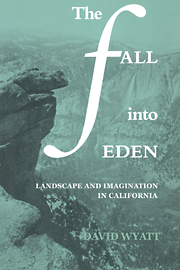Book contents
- Frontmatter
- Contents
- List of illustrations
- Acknowledgments
- Prologue: The mythology of the region
- 1 Spectatorship and abandonment: Dana, Leonard, and Frémont
- 2 Muir and the possession of landscape
- 3 King and catastrophe
- 4 Mary Austin: nature and nurturance
- 5 Norris and the vertical
- 6 Steinbeck's lost gardens
- 7 Chandler, marriage, and “the Great Wrong Place”
- 8 Jeffers, Snyder, and the ended world
- Epilogue: Fictions of space
- Notes
- Bibliography
- Index
7 - Chandler, marriage, and “the Great Wrong Place”
Published online by Cambridge University Press: 18 December 2009
- Frontmatter
- Contents
- List of illustrations
- Acknowledgments
- Prologue: The mythology of the region
- 1 Spectatorship and abandonment: Dana, Leonard, and Frémont
- 2 Muir and the possession of landscape
- 3 King and catastrophe
- 4 Mary Austin: nature and nurturance
- 5 Norris and the vertical
- 6 Steinbeck's lost gardens
- 7 Chandler, marriage, and “the Great Wrong Place”
- 8 Jeffers, Snyder, and the ended world
- Epilogue: Fictions of space
- Notes
- Bibliography
- Index
Summary
Landscape south of Tehachapi resolves into a subdivision of the mind. Joshua Tree, San Gorgonio, the Channel Islands – these outposts of wilderness make little impress on the whole. It has been like this from the start in Southern California. Actual development came late (Los Angeles expanded from 12,000 in 1884 to 50,000 in 1887), but the Anglo-American experience of the Los Angeles basin nevertheless began as one in which the extension of a mental grid over physical space ruled out unmediated natural encounter. The vast ranchos marked out by nothing more than a skull on a post staked their claims with a fiction of ownership as thoroughgoing as the miner's forty square feet of pay dirt. In theory there was little free space. And the land booms that tried to lure the first large populations confronted the immigrant with whole towns laid out in comforting right angles, lots that were to become nothing more than homes for tumbleweeds. “In Los Angeles County in the two principal boom years,” Franklin Walker tells us, “there appeared sixty mushroom towns with more than 500,000 lots and less than 2,500 people in all of them put together.” T. S. Van Dyke's novel about the boom, Millionaires of a Day (1890), initiates the tradition of life in the basin as a fantasy of development gone wrong. His Virgilian hopes for a country of small landholders lost in a “maze of green” contracts into the fact of real estate, “a sufficient acreage chopped up fine enough.” Oppression of space by the human casually reverses itself, for Joan Didion, into oppression of the human by space.
- Type
- Chapter
- Information
- The Fall into EdenLandscape and Imagination in California, pp. 158 - 173Publisher: Cambridge University PressPrint publication year: 1986

